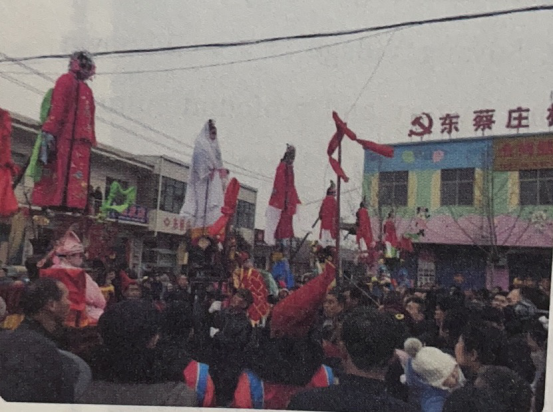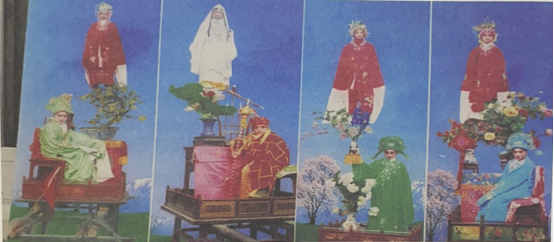传承人:省级-2017年09月 第4批:于清利
申报地区:偃师市2011年12月 第3批

东蔡庄高抬“故事”是源于明朝中期的偃师邙岭乡东蔡庄村的一种民间舞蹈。因人物造型多以戏剧故事和民间传说中的人物为原型,故名“故事”。又因扮演者多被巧妙地固定在高高的一枝花上,下有八人抬架行进,又名“高抬”。
“故事”原本是民间社火的一种,最早来源于古代的祭祀活动,用来祭祀玉皇、火神等,祈祷四季平安,风调雨顺,免遭人间灾祸。由人装扮成神,先在庙内表演,然后走村串街供人们观赏,俗称为“行社”。由于在本来就不宽敞的街巷里游走,站于后面的人群难以观看,这就需将扮演者设法固定抬高。后经历代民间艺人精心研制,多次尝试,逐步产生了钢制“拐子”和“吊拐”。拐子用来抬高人物,吊拐用来固定人物,又将表演者由大人改换成8岁左右,体重不得超过60斤的孩童来扮演,通过拐子和吊拐的伪装组合,显得更加完美而又奇险,既增加了表演的主动性,更方便了观众的欣赏。
东蔡庄村共有六道社,拥有故事六桌,每年新春庙会,6桌故事各展风采,多为下生上旦,其内容有“西厢记”、“风雪配”、“二度梅”等,近年又有“红灯记”、“智取威虎山”、“江姐”等,故事人物或立于枝头、花中,或站于剑戟、斧头上,各具特色,惟妙惟肖。另有狮子、大鼓,不同形式的秧歌、舞蹈等云集广场,十分壮观。
“故事”社曾有一度搁浅,无人过问,服装道具失落严重,面临失传之势。改革开放以来,东蔡庄村两委积极响应保护文化遗产的号召,开始重视民间文化,为了保护“故事”社,九十年代末专门组织有关技术人员组建了“故事研究会”。经过十几年的努力,研究人员潜心搜集,整修各种拐子十余种,使“故事”社起死回生,重现风采。

Gaotai Gushi in the Dongcaizhuang Village is a folk dance originated from Dongcai Village, Mangling Township, Yanshi in the middle of the Ming Dynasty(1368-1644). In its name, "Gushi" comes from the fact that its character modeling are inspired by characters in dramatic stories and folk legends. And Gaotai(high stage)" refers to the fact that the performers are standing on a flower shaped structure carried by eight person during performance. Gushi is a kind of traditional form of Shehuo(a kind of Chinese folk entertainment to celebrate the Spring Festival). It was originated from the ancient sacrificial activities for peace in the four seasons and good weather for crops. At the very beginning, Gushi was performed during parade in narrow alleys, it is difficult for the crowd at the back to see the show. After many attempts, folk artists in later generation made steel"guaizi"and"diaoguai" to lift and the performer and secure him or her during the performance. The performers are mainly children aged 8 or so, weighing no more than 60 jin(a unit of weight =1/2 kilogram).

